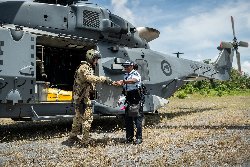Cablegate: Croatia Tip Interim Assessment
VZCZCXYZ0000
RR RUEHWEB
DE RUEHVB #0793/01 3230801
ZNR UUUUU ZZH
R 180801Z NOV 08
FM AMEMBASSY ZAGREB
TO SECSTATE WASHDC 8782
UNCLAS ZAGREB 000793
SIPDIS
SENSITIVE
DEPT FOR EUR/PGI, G/TIP, G-ACBlank
E.O. 12958: N/A
TAGS: PHUM KTIP PGOVKCRM KWMN PREL SMIG HR
SUBJECT: CROATIA TIP INTERIM ASSESSMENT
1. (U) SUMMARY: The Croatian government has continued to actively
address the issue of trafficking in persons during 2008. The
government has worked aggressively to increase public awareness and
to train government employees, public officials, and NGOs in
identification and prevention. The government has also begun work on
amendments to Croatian law to better protect the rights of victims
and enable harsher sentencing for convicted traffickers. END
SUMMARY.
2. (U) In mid-2008, the GOC completed a four year EU Community
Assistance for Reconstruction, Development, and Stabilization
(CARDS) program entitled "Combating Trafficking in Human Beings".
The 1 million Euro program co-funded by the Croatian government
provided education on trafficking in persons to 314 people,
including social workers, health care workers, police officials and
government lawyers.
3. U) Based on conclusions from the CARDS project, the GoC's Office
for Human Rights sent a list of recommendations to a Ministry of
Justice working group tasked with proposing amendments to the
Criminal Code and Criminal procedure acts in regards to Trafficking
in Persons. One of the amendments introduces a new mandatory
sentencing of no less than five years if the trafficking offence was
committed by an official in the performance of his duties or if the
trafficker deliberately or through gross negligence endangered the
life of the victim. Other amendments would limit the number of
interviews a TIP victim would have to endure in order to prevent
re-victimization. The amendments are currently awaiting approval in
parliament.
4.(U) In preparation for June's Euro Cup soccer championship the GOC
produced and aired a nation wide television campaign warning
Croatian fans of the increased risk of trafficking of men, women,
and children at these events, especially in the area of prostitution
and forced labor. The advertising campaign featured one of Croatia's
most revered and famous sports stars urging Croatians to be aware
and report trafficking. The campaign was aired throughout the day
but was also shown after the nightly state news program, the most
watched television program in Croatia.
5. (U) In June a cooperation agreement was signed between the
Ministry of the Interior (MOI), the Ministry of Health and Social
Welfare, and two NGOs in order to clearly define the
responsibilities of each signatory in regards to victim assistance.
The agreement allows NGOs to provide primary assistance to the
victim, places the responsibility of safe return to the country of
origin with the MOI, and allows the Ministry of Health to be present
during interviews of child victims and to provide child victims with
a legal guardian.
6. (U) In October, the Croatian Ministry for Foreign Affairs and
European Integration and the International Organization for
Migration (IOM) organized a one day conference entitled "The Role of
Diplomatic Personnel in Combating Trafficking in Human Beings." The
results of a joint capacity building project between IOM and the
ministry were presented at the conference. The project, a key
element of which was improving potential victim identification
procedures, trained 17 diplomatic and consular staff who further
trained 60 colleagues on issues related to trafficking in persons.
Additionally, the project produced information brochures in 5
different languages designed to help assist foreigners, visa
seekers, Croatian travelers and potential TIP victims. The project
also produced a handbook and curriculum for Croatia's Diplomatic
Academy for further education on TIP issues. As a result of the
conference, consular officers at the Croatian Embassy in Rome have
already produced a report which examines trends in Croatian visa
applications from Italy and identifies key indicators that can be
used to identify possible TIP victims.
7. (U) The conference was followed by an outdoor information fair
held in the heart of Zagreb on Saturday, October 18, to mark EU
Anti-Trafficking Day. Organized by the Government's Human Rights
Office and related NGOs, the event aimed to raise public awareness
about the threat of TIP. In addition to information booths and
informative leaflets there were also music and dance performances.
8. (U) In October the Office for Human Rights organized two seminars
on "How to Recognize the Victims of Trafficking in Persons". The
first seminar was organized with the cooperation of an NGO from the
Dalmatian coastal town of Sibenik and trained 30 family center
workers. There are ten family centers in Croatia established at a
county level by the Ministry of Family that work with local families
and youth in areas of therapy and prevention. Workers at these
centers include social workers, lawyers, and psychiatrists. The
second seminar was organized with the Ministry of Tourism and
trained 40 employees in the tourism sector on ways to identify
trafficking victims.
9.(U) In 2008 the government's Office for Human Rights provided
287,000 kuna (USD 57,400) to fund eight projects aimed at
suppressing TIP with NGOs throughout Croatia. The projects included
programs aimed at educating the judiciary about trafficking in
persons, increasing cooperation between NGOs and local authorities,
youth education and prevention, and media awareness.
10. (U) In September the GOC presented at an OSCE organized seminar
for national anti-trafficking rapporteurs from participant states in
the Alliance Against Trafficking in Persons. The Croatian government
was invited to present their system of reporting as an example of
comprehensive coverage and good practice for the countries of the
region. The goal of the seminar was to support and encourage
participating states in the implementation of commitments to fight
TIP, while providing a venue for exchanging information, enhancing
dialogue, and networking among national authorities working in the
TIP area.
11. (U) In September, the GOC also participated in an OSCE organized
conference on identifying ways to successfully prosecute cases of
human trafficking. Realizing that prosecution and subsequent
sentences for human trafficking remain low in all 56 OSCE
participating states, the conference's aim was to enhance national
capacities and to provide an opportunity for states to exchange
experiences, share best practices, and identify ways to successfully
prosecute cases of all forms of human trafficking.
12. (U) The government reported that five trafficking victims have
been identified this year to date. Three of the victims were male
and all were trafficked with the intent of forced labor. The
government also reported four final trafficking convictions in which
the defendants were sentenced from terms ranging from one year to 20
months.
BRADTKE


 UN News: Healing Page By Page In Earthquake-affected Türkiye
UN News: Healing Page By Page In Earthquake-affected Türkiye Save The Children: Rate Of Attacks On Healthcare in Gaza Higher Than In Any Other Conflict Since 2018
Save The Children: Rate Of Attacks On Healthcare in Gaza Higher Than In Any Other Conflict Since 2018 UN News: Green Light For New Cholera Vaccine, Ukraine Attacks Condemned, Action Against Racism
UN News: Green Light For New Cholera Vaccine, Ukraine Attacks Condemned, Action Against Racism Laureus: Grand Slam Champion Garbiñe Muguruza Announces Retirement Ahead Of Laureus World Sports Awards
Laureus: Grand Slam Champion Garbiñe Muguruza Announces Retirement Ahead Of Laureus World Sports Awards Carbon Market Watch: Going For Green - Is The Paris Olympics Winning The Race Against The Climate Clock?
Carbon Market Watch: Going For Green - Is The Paris Olympics Winning The Race Against The Climate Clock? New Zealand Defence Force: NZDF Working With Pacific Neighbours To Support Solomon Islands Election
New Zealand Defence Force: NZDF Working With Pacific Neighbours To Support Solomon Islands Election